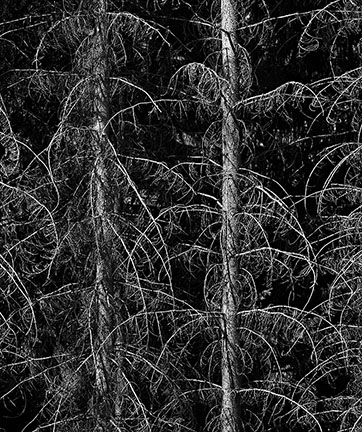Why Bumble Bees Can’t Fly
One of the favourite debates on web discussion forums is – "why film is or is not sharper then digital". Experienced photographers know through the evidence of their own eyes that, other things being equal – same lens, similar ISO, etc; in real-world photographs digital is incontrovertibly sharper than film. Yet the debates continue.
This is reminiscent of the urban myth that bumble bees can’t fly. Their wings are far too small to generate enough lift given their weight. A lift to weight ratio thing. (Sound familiar?)
And for those that are interested, this apparently has something to do with the way bees use their wings and the lift generated by vortices that swirl behind the moving wing edges. According to those knowledgeable about insect flight aerodynamics the complexities include "continuously changing angles of attack, interactions of opposite wings at the top of the stroke, issues of how many chord lengths of travel are needed for full lift to be developed, vortex shedding and reformation (with opposite sign) at the bottom of the stroke, spanwise flow…"
Make sense to you?
No, nor to me either. And that’s the problem. A narrow-minded aircraft designer would look at the lift to weight ratio of the bumble bee and state that it can’t fly, even though if you asked any bee it would say"Bzzzzzz"– which freely translates as, "get a life!"
Which brings us to the matter of film vs. digital resolution.

Bare Branches – Norway, June 2005
Photographed with a Contax 645 and Phase One P25 back with Zeiss 350mm f/4 Apo-Tele Sonnar @ ISO 100
___________________________________________________________
Pixels vs. Grain
Just as the aircraft designer simply looked at the bee’s lift to weight ratio and said that they obviously can’t fly, the self-professed photographic experts shoots a high resolution target and then proudly declares that film outresolves digital, and they have the shots to prove it.
What’s wrong with this picture? (Pun intended).
Here’s what’s wrong. A very fine-grain film has grain particles that are about 2 microns in size. A typical DSLR has individual pixels that are about 6 microns in size. Ergo, film should outresolve digital. Right?
Not so fast! Here’s the catch that many testers trip over. Grain particles are binary. An individual film grain can only be either black or not-black, on or off, exposed or not exposed. Sort of a binary device. A photo site (pixel), on the other hand, has a range of thousands of brightness levels, because it’s an analog device. (Curious isn’t it, that at this level film is binary and digital is analog?)
What this means is that it takes a clump of between 30-40 grains of film to represent a full tonal range, (similar in concept to the dithering done by inkjet printers to produce continious tones), while on a sensor each individual pixel can reproduce from hundreds to thousands of tonal levels.
So now we photograph a resolution chart, which is high resolution black and white. There’s a line, or there isn’t a line. This gives film an advantage because each grain can record whether or not it sees something. Ergo, high resolution film is going to measure as having higher resolution than digital.
But unless your idea of a good time is photographing black and white resolution charts, and instead you’d rather photograph your cat, your children, a sunset, or a flower, film’s theoretical advantage simply goes away in a puff of smoke.
This is why the so-called web forum experts can convince some photographers that bumble bees can’t fly… errr… I mean, film can outresolve digital.
The next time someone writes this nonsense, tell them they’re wrong because of"vortex shedding".
Thought you’d like to know.
Michael Reichmann – July, 2005
You May Also Enjoy...
Jeff Schewe and Kevin Raber Live In Chicago
FacebookTweet BenQ Creative Masterclass with Luminous Landscape Saturday, April 21st, 2018 Chicago, IL Join us for an amazing Creative Photography Masterclass with Luminous Landscape and
In The Palouse – Luminous-Landscape’s Palouse Workshops
It is time for my annual Palouse trip. This year I’ll be in the Palouse for two weeks, running two back-to-back workshops with four participants


